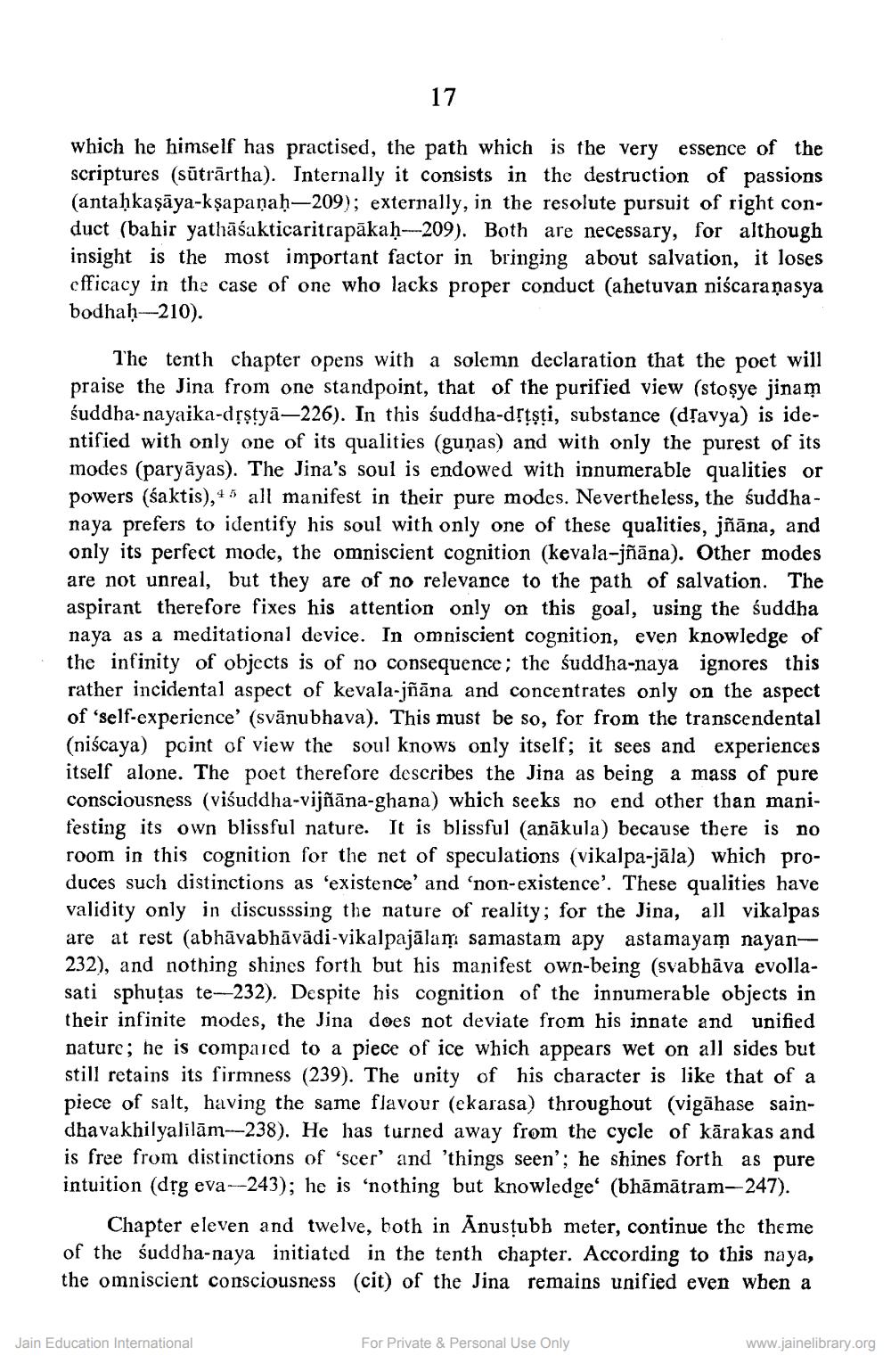________________
17
which he himself has practised, the path which is the very essence of the scriptures (sūtrartha). Internally it consists in the destruction of passions (antaḥkaṣāya-kṣapaṇaḥ-209); externally, in the resolute pursuit of right conduct (bahir yathāśakticaritrapakaḥ-209). Both are necessary, for although insight is the most important factor in bringing about salvation, it loses efficacy in the case of one who lacks proper conduct (ahetuvan niścaraṇasya bodhaḥ-210).
The tenth chapter opens with a solemn declaration that the poet will praise the Jina from one standpoint, that of the purified view (stoṣye jinam śuddha-nayaika-dṛṣṭyā-226). In this suddha-dṛṭşti, substance (dṛavya) is identified with only one of its qualities (gunas) and with only the purest of its modes (paryāyas). The Jina's soul is endowed with innumerable qualities or powers (śaktis), +5 all manifest in their pure modes. Nevertheless, the śuddhanaya prefers to identify his soul with only one of these qualities, jñāna, and only its perfect mode, the omniscient cognition (kevala-jñāna). Other modes are not unreal, but they are of no relevance to the path of salvation. The aspirant therefore fixes his attention only on this goal, using the suddha naya as a meditational device. In omniscient cognition, even knowledge of the infinity of objects is of no consequence; the śuddha-naya ignores this rather incidental aspect of kevala-jñāna and concentrates only on the aspect of 'self-experience' (svānubhava). This must be so, for from the transcendental (niscaya) point of view the soul knows only itself; it sees and experiences itself alone. The poet therefore describes the Jina as being a mass of pure consciousness (viśuddha-vijñāna-ghana) which seeks no end other than manifesting its own blissful nature. It is blissful (anākula) because there is no room in this cognition for the net of speculations (vikalpa-jāla) which produces such distinctions as 'existence' and 'non-existence'. These qualities have validity only in discusssing the nature of reality; for the Jina, all vikalpas are at rest (abhāvabhāvādi-vikalpajālam samastam apy astamayam nayan232), and nothing shines forth but his manifest own-being (svabhāva evollasati sphutas te-232). Despite his cognition of the innumerable objects in their infinite modes, the Jina does not deviate from his innate and unified nature; he is compared to a piece of ice which appears wet on all sides but still retains its firmness (239). The unity of his character is like that of a piece of salt, having the same flavour (ekarasa) throughout (vigāhase saindhavakhilyalilām-238). He has turned away from the cycle of kārakas and is free from distinctions of 'scer' and 'things seen'; he shines forth as pure intuition (drg eva-243); he is 'nothing but knowledge' (bhāmātram-247).
Chapter eleven and twelve, both in Anusṭubb meter, continue the theme of the suddha-naya initiated in the tenth chapter. According to this naya, the omniscient consciousness (cit) of the Jina remains unified even when a
Jain Education International
For Private & Personal Use Only
www.jainelibrary.org




